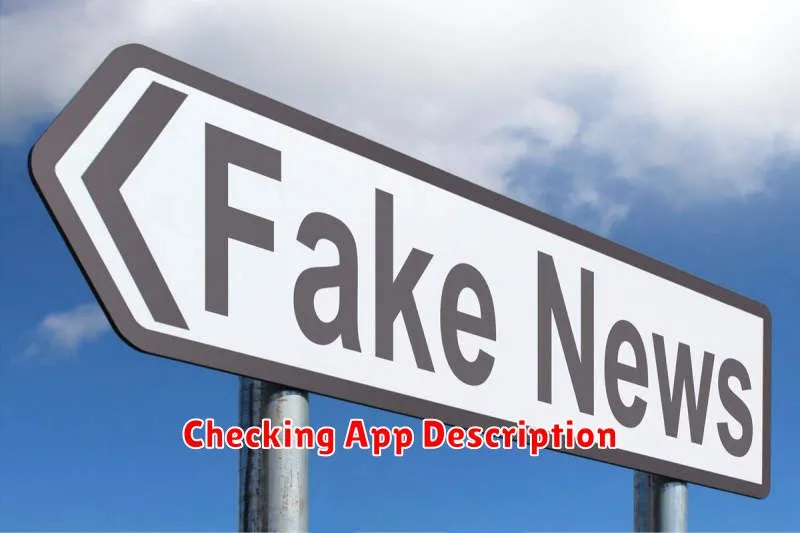In today’s digital age, the Google Play Store serves as a vast marketplace for mobile applications, offering users a plethora of tools, games, and utilities. However, this expansive ecosystem is unfortunately susceptible to malicious actors who attempt to deceive users by distributing fake apps. These counterfeit applications often mimic legitimate ones, aiming to steal personal information, spread malware, or generate fraudulent revenue. Protecting yourself from these threats requires vigilance and a comprehensive understanding of how to identify suspicious apps.
This guide, “Spotting the Fakes: A Guide on How to Identify Fake Apps on the Play Store,” is designed to equip you with the knowledge and skills necessary to navigate the Play Store safely and avoid becoming a victim of fake app scams. We will delve into the key indicators of a fraudulent app, from examining developer profiles and user reviews to scrutinizing app permissions and design elements. By understanding these red flags, you can significantly reduce your risk of downloading and installing malicious software on your device.
Why are Fake Apps a Problem?
Fake apps present a significant threat to user security and data privacy. These deceptive applications often mimic legitimate ones to trick users into downloading them.
One major issue is malware distribution. Fake apps frequently contain viruses, trojans, and other malicious software that can compromise your device and steal sensitive information such as passwords, credit card details, and personal data.
Furthermore, they can lead to financial losses through fraudulent charges, subscription scams, or by redirecting users to phishing websites designed to steal credentials. Another concern is the potential for data breaches, as fake apps may collect and transmit your data to unauthorized third parties.
Finally, the presence of fake apps erodes trust in the app ecosystem, making users more hesitant to download new applications, even those from legitimate developers.
Checking Developer Information: A Key Indicator
A crucial step in identifying fake apps is to examine the developer information. Legitimate apps are typically published by reputable developers with a history of creating reliable software. When viewing an app on the Play Store, carefully inspect the developer’s name. Does it match the official company or brand?
Here’s what to look for:
- Developer Name: Is it spelled correctly and does it align with the official company’s name? Typos are a major red flag.
- Developer Website: Does the developer have a legitimate website? A link to the website should be available on the app’s Play Store page. Verify that the website is professional and provides contact information.
- Developer Address: Legitimate developers often provide a physical address. The absence of an address, or a vague one, could indicate a fake app.
- Other Apps: Check what other apps the developer has published. Do they seem legitimate and related, or are they a random assortment of unrelated apps?
Be suspicious of developers with generic names, missing contact information, or a lack of a professional online presence. These are strong indicators of a potentially fake app.
Examining App Permissions: What Are They Accessing?
One of the most crucial steps in identifying fake or malicious apps is carefully examining the permissions they request. Legitimate apps will only ask for permissions necessary for their core functionality. Fake apps, however, may request excessive or irrelevant permissions to gain access to your personal data.
Consider these points:
- Why does this app need this permission? If a flashlight app requests access to your contacts, it’s a red flag.
- Is the scope of the permissions too broad? An app might need location access, but does it really need precise location when a general area would suffice?
Be particularly wary of apps requesting permissions related to:
- Contacts
- SMS messages
- Call logs
- Camera
- Microphone
- Location (especially continuous background access)
If an app’s requested permissions seem suspicious or excessive, it’s best to avoid downloading it. Always prioritize your privacy and security by carefully scrutinizing what an app wants to access on your device.
Reading User Reviews: What Are Others Saying?
User reviews offer valuable insights into the legitimacy and functionality of an app. Before downloading, take the time to carefully read through a variety of reviews, paying attention to both positive and negative feedback.
Look for recurring themes or complaints. Are multiple users reporting similar issues, such as crashes, unexpected behavior, or intrusive advertising? A high volume of negative reviews, especially those mentioning potential security risks or misleading functionality, should raise a red flag.
Be aware that fake apps may also feature fake reviews. Watch out for reviews that sound generic, overly enthusiastic, or use suspiciously similar language. Genuine reviews tend to be more specific and provide details about the user’s experience.
Consider the overall rating of the app. While a few negative reviews are normal, a consistently low rating (below 3 stars) is a strong indication that the app may not be trustworthy.
Analyzing Download Numbers: Does it Seem Legitimate?
Download numbers can provide a significant clue about the legitimacy of an app. While not a foolproof method, a very low number of downloads for an app that claims to be popular should raise a red flag. Established and legitimate apps usually boast download numbers in the thousands, if not millions.
Consider the app’s purported function and age. A newly released app, even if legitimate, might have fewer downloads initially. However, a fake app mimicking a well-known, established app and displaying only a handful of downloads is highly suspicious.
Furthermore, be wary of suspiciously inflated download numbers. While harder to detect, unrealistically high download numbers in a short period, particularly coupled with poor reviews, may indicate the use of bots or other fraudulent methods to artificially inflate popularity.
Comparing App Icons and Names with Official Versions
One of the most straightforward methods to identify fake apps involves a close comparison of the app’s icon and name with the official version. Fake apps often attempt to mimic legitimate ones, but subtle differences can be revealing.
Icon discrepancies might include variations in color, resolution, or design elements. Pay close attention to the sharpness and overall quality of the icon; fake apps often have poorly rendered or pixelated icons.
Similarly, scrutinize the app’s name. Fake apps may use slight misspellings, added characters, or variations in capitalization to deceive users. Compare the name directly to the official app listing on the Google Play Store to ensure accuracy. For example, “Faceboook” instead of “Facebook.”
If possible, visit the official website of the app developer to confirm the correct icon and naming convention used for their application.
Being Wary of Suspicious Updates and Requests
Staying vigilant about app updates and permission requests is crucial in identifying potentially fake or malicious applications. Fake apps often mimic legitimate software but may contain malware or seek to steal your data.
Examine update details carefully. Be suspicious of updates that:
- Arrive shortly after you install the app (could indicate rushed or sloppy development).
- Request significantly more permissions than the app initially required.
- Lack clear release notes or descriptions of the changes made.
Be cautious of unusual permission requests. If an app, especially one you’ve used for a while, suddenly asks for access to your contacts, location, or other sensitive data that seems irrelevant to its function, proceed with extreme caution. Deny the permission if you’re unsure.
Verify the app’s legitimacy before installing any updates or granting new permissions. Check the developer’s information and user reviews as described in other sections of this guide.
Using Antivirus Apps for Extra Protection
Employing antivirus applications is a proactive measure in safeguarding your device against malicious fake apps. These apps scan installed applications and files for known malware signatures and suspicious behavior.
How Antivirus Apps Help:
- Real-time Scanning: Continuously monitors apps and files as they are accessed.
- Malware Detection: Identifies and removes known malware threats.
- Suspicious Activity Alerts: Notifies you of apps exhibiting unusual behavior, such as excessive data usage or unauthorized access to device features.
While not foolproof, integrating a reputable antivirus solution provides an additional layer of security. Ensure the antivirus app itself is legitimate by downloading it from the official Google Play Store and verifying the developer’s credentials.
Reporting Fake Apps to the Google Play Store
Once you have identified a potentially fake app, it is crucial to report it to the Google Play Store. Reporting helps protect other users from downloading and using malicious or misleading applications.
Steps to Report an App:
- Open the Google Play Store app.
- Navigate to the app listing you want to report.
- Tap the three vertical dots (menu) in the top-right corner of the app’s page.
- Select “Flag as inappropriate.”
- Choose the reason that best describes why you are reporting the app (e.g., “Copycat app,” “Spam,” “Inappropriate content”).
- Submit your report.
By taking these steps, you contribute to a safer app ecosystem and help Google identify and remove fraudulent applications from the Play Store.
Staying Informed About Common Scam Tactics

Staying informed about common scam tactics is crucial in protecting yourself from fake apps. Cybercriminals constantly evolve their methods, making it imperative to stay updated on the latest threats.
Phishing Attempts: Be wary of apps that request personal information upfront, especially if it seems unusual or unnecessary. Legitimate apps typically request such information within a secure environment, after establishing trust.
Subscription Traps: Many fake apps lure users with free trials, then automatically enroll them in expensive subscriptions. Read the fine print carefully and be cautious of overly aggressive promotional tactics.
Adware & Malware Disguises: Some fake apps are designed to inundate your device with unwanted ads or even install malware. Regularly scan your device with a reputable antivirus program.
Fake Updates: Be skeptical of unusual update requests outside the Play Store’s official channels. Scammers may use fake updates to install malicious software.
Checking App Description

The app description on the Google Play Store is a critical source of information. Scrutinize it carefully for red flags indicative of a fraudulent application. Authentic apps usually feature well-written, grammatically correct descriptions that accurately reflect the app’s functionality and purpose.
Look for the following:
- Poor Grammar and Spelling: Numerous errors suggest a lack of professionalism and potential fraud.
- Vague or Generic Descriptions: Authentic apps clearly state their features and benefits.
- Unrealistic Claims: Be wary of descriptions promising extraordinary results or features that seem too good to be true.
- Inconsistencies: Ensure the description aligns with the app’s title, developer, and advertised functionality.
- Excessive Keywords: Overuse of keywords to manipulate search rankings can be a sign of a low-quality or fake app.
Compare the description with that of the official app (if you know it). Discrepancies are a major cause for concern. A legitimate developer takes time to create a detailed and accurate description of the application.

